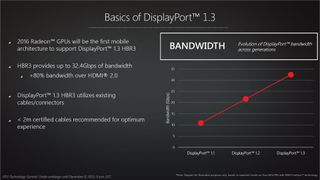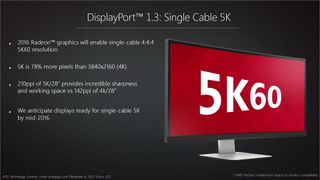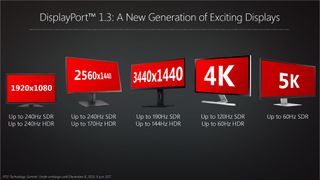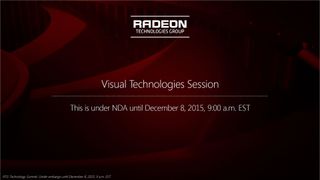AMD RTG Summit: HDR, Displays, FreeSync, and More

Higher Refresh Rates with HDMI 2.0 and DP 1.3
Last but not least, AMD announced that their future 2016 GPUs will support HDMI 2.0a and DisplayPort 1.3. HDMI 2.0a support will be good for existing displays that feature that standard, but DP 1.3 is what really gets us excited. HBR3 (High Bitrate 3) over DP 1.3 provides up to 32.4Gbps of bandwidth, an 80 percent increase over HDMI 2.0 and DP 1.2. Why would we possibly need all that bandwidth? There are three primary reasons: higher resolutions, higher refresh rates, and HDR.

Starting with HDR, it will require more bandwidth than SDR. That dovetails into the second item, which is support for higher resolutions—with and without HDR. You can do SDR at 60Hz with 4K content, but HDR would require more bandwidth. Similarly, 5K displays need 78 percent more bandwidth than 4K displays, which is why existing solutions like Dell’s UltraSharp 5K display use dual DisplayPort. DP 1.3 will allow for a single cable and connection to run 5Kp60.

Finally, and this is the one that excites us, DP 1.3 will enable support for higher refresh rates. Sure, 240Hz at lower resolutions sounds cool, but we don’t generally perceive a huge improvement going above 120Hz. But 4K at 120Hz? Hell yeah, sign us up! We’ve played with several 4K displays over the years, including the Acer XB280HK with G-Sync support. While getting variable refresh rates at 30-60Hz is nice, where things really become smooth is in the 75-100Hz range. Sadly, DP 1.2 simply can’t accommodate the bandwidth for higher refresh rates at 4K, at least not without dropping from 4:4:4 chroma down to 4:2:2 or 4:2:0. DP 1.3 fixes all of that and should allow for much better FreeSync ranges on future monitors.

Wrapping Things Up
The good news for many of the above technologies is that the hardware and standards are ready. FreeSync over HDMI will work with AMD’s R9 300/Fury and upcoming 2016 GPUs, and these same GPUs will be able to support HDR content as well—though you’ll want a DP 1.3 connection for the best experience going forward. The bad news is that you’ll need a new display to take advantage of most of this stuff. This is particularly important considering the lifespan of most displays. They’re not like CPUs and GPUs where upgrades are relatively common; instead, most users only update their display when their old one breaks or becomes hopelessly outdated.
Consider those who jumped on the 30-inch bandwagon way back in 2005; even ten years later those old displays are still hanging around. As someone who only recently shifted to a 4K panel on the desktop, I can say that in many ways going from WQXGA IPS (2560x1600) to UHD 4K TN (3840x2160) was more of a lateral move than a clear improvement. Higher resolution support and variable refresh rates were all well and good, but going from IPS to TN was a clear downgrade, and HiDPI isn’t all it’s cracked up to be either. Now, of course, all existing displays are about to be made “obsolete,” even though it will be years before the majority of users upgrade.
If you’re thinking about buying a new computer display in the near future, our advice right now is to carefully consider what will be happening in the coming year. If you’re okay with SDR content, no worries—you’re not alone. But if you’re thinking about buying a “dream” display, don’t blow a wad of cash on something that will be superseded in the very near future. And when you do get around to upgrading, buy the best display you can reasonably afford, because more likely than not you’re going to be staring at those pixels every day for years to come!
Looking at the bigger picture, while we can't release details of everything that was presented at the RTG Summit (yet), the event overall conveyed a great message. With Raja Koduri heading up the Radeon Technologies Group, AMD has the right man in place to lead their charge into the next era of computer graphics. There was a positive vibe and energy among the AMD engineers that has been lacking in previous years. RTG is still young, and there's plenty of work yet to be completed, but the launch and then hotfix of the Crimson drivers shows that AMD is serious about making some much-needed changes. Not all change is bad.
The biggest gaming news, reviews and hardware deals
Keep up to date with the most important stories and the best deals, as picked by the PC Gamer team.
Jarred's love of computers dates back to the dark ages when his dad brought home a DOS 2.3 PC and he left his C-64 behind. He eventually built his first custom PC in 1990 with a 286 12MHz, only to discover it was already woefully outdated when Wing Commander was released a few months later. He holds a BS in Computer Science from Brigham Young University and has been working as a tech journalist since 2004, writing for AnandTech, Maximum PC, and PC Gamer. From the first S3 Virge '3D decelerators' to today's GPUs, Jarred keeps up with all the latest graphics trends and is the one to ask about game performance.
Most Popular


